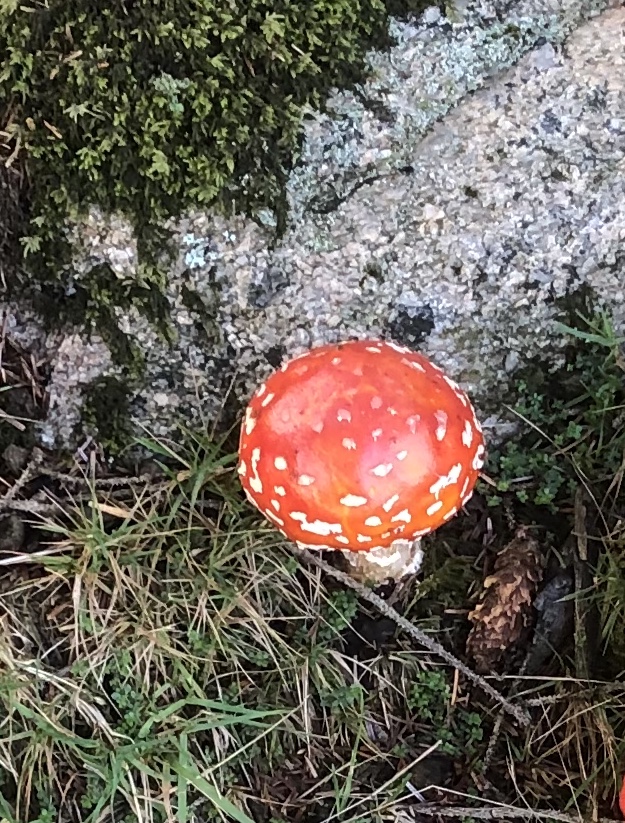What are fungi and how important are they?
All living organisms are organised into large groups called Kingdoms. Fungi were originally placed in the Plant Kingdom then, scientists learned that fungi were more closely related to animals than to plants. Then scientists decided that fungi were not sufficiently similar to animals to be placed in the animal kingdom and so today fungi have their own Kingdom – the Fungal Kingdom. There are thought to be around up to 3.8 million species of fungi, of which only 120,000 have been named.
The fungal kingdom is largely hidden from our view and we usually only see the “fruit” of a fungus. The living body of a fungus is called a mycelium and is made up of a branching network of filaments known as hyphae. Fungal mycelia are usually hidden in a food source like wood and we only know they are there when they develop mushrooms or other fruiting bodies. Some fungi only produce microscopic fruiting bodies and we never notice them.
Fungi feed by absorbing nutrients from the organic material that they live in. They digest their food before they absorb it by secreting acids and enzymes. Different fungi have evolved to live on various types of organic matter, some live on plants (Magneportha grisea – the rice blast fungus), some on animals (Trichophyton rubrum – the athlete’s foot fungus) and some even live on insects (Cordyceps australis).

Helpful fungi
Most of us use fungi every day without even knowing it. We eat mushrooms and Quorn, but we also prepare many other foods using fungi. Baker’s yeast Saccharomyces cerevisiae is a fungus and puts the bubbles in wine and beer and makes bread rise. The koji process uses the fungi Aspergillus sojae and Aspergillus oryzae to produce the oriental foods, soy sauce and miso. We also use fungi to produce flavourings.
Several important drugs have come from fungi. The antibiotic penicillin and ciclosporin (a drug that stops organ rejection after transplantation) are 2 examples as well as the first statin to lower cholesterol and a new antifungal class the echinocandins. Research scientists use several fungi to investigate basic functions that occur in all cells because they are simple and easy to grow; some fungi are used in biochemistry and cancer research.
Fungi are an essential part of the carbon cycle – responsible for breaking down dead organic matter which allows nutrients to be cycled through the ecosystem. Many plants cannot grow without the fungi that inhabit their roots and supply them with essential nutrients, known as mycorrhizal fungi. In fact, trees have a symbiotic relationship with fungi called the ‘Wood Wide Web’ which is the underground network of microbes that connects trees, allowing them to communicate.
Without fungi we would not have bread, beer, wine or antibiotics, but more importantly without the nutrient recycling and plant nutrition provided by fungi – we probably could not survive at all.
Harmful fungi
Fungi that cause plant diseases result in the loss of billions of dollars a year due to crop-damage and post-harvest decay. Four plant fungal diseases (what stem rust, corn smut, rice blast and soybean rust) are responsible for the loss of enough food to feed 100’s of millions of people, as well as huge economic costs. For example, wheat stem rust in Europe accounts for the loss of 1.6 billion Euros.
Several fungi produce dangerous substances called toxins, which if eaten via contaminated food – can be fatal to man and other animals. This is particularly a problem in developing countries where crop contamination can result in severe famine – or if eaten gives rise to various forms of cancer including liver cancer. Contamination of corn with one toxin called aflatoxin, produced by the fungus Aspergillus flavus, costs farmers in the U.S. alone – $100 million annually.
In humans fungi cause relatively minor skin infections such as ringworm and athlete’s foot, but several types of fungi – whose spores are carried around in the air we breathe – also cause several deadly diseases which can be hard to treat. These types of fungi are not generally visible to the naked eye – but it is their airborne spores which can cause illness. Fungi that can cause life-threatening infections in people include Aspergillus fumigatus, and other Aspergillus species, Candida albicans and Cryptococcus neoformans. A new multi-resistant fungus called Candida auris has arisen around the world probably as a result of climate change.
Although the planet cannot survive without fungi, the harmful species can cause serious illness often fatally, in hundreds of thousands of people worldwide. Fungi are also responsible for many animal and insect diseases, including affecting honey bees. Bats are particular risk of new transmissible fungal disease called White Nose Syndrome, that is killing many colonies. Frogs are affected by chitrid fungi that dry out their skin – many species of frog are now extinct after infection with these fungi.
Climate change and species extinctions
Overall, more species have become extinct because of fungal infections than bacteria or viruses, notably frog and tree species. Bananas are at great risk of extinction, as the large food species exported everywhere, is threatened by one fungus now transferred from Asia to Latin America. It is thought that fungal infections killed off the dinosaurs 66 million years ago and possibly lead to a mass extinction 250 million years ago. Climate change is accelerating the movement of fungi around the world.
